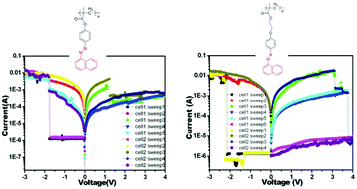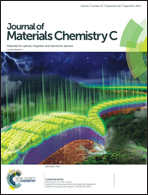Rewritable ternary data storage devices based on polymethacrylate containing pendent azobenzene–naphthalene with the combined effects of conformation change and charge traps†
Abstract
In this paper, we combined shallow electron trap azobenzene with planar naphthalene in the side chains of polymethacrylate. The sandwich-structured ITO/polymer/Al device shows different memory characteristics with the different side-chains of the polymer. When the alkyl length is 0, the device could only be turned to a moderate OFF state from the ON state, while when the alkyl length is 2 carbons the device can be turned to a moderate OFF state first and then to the original OFF state as the electric field is increased. It has been rarely reported that one device based on pendent polymers shows three different current states under a continuous electric field, which could be corresponding to “0”, “1” and “2” for ternary data storage. The conductance switching can be explained in terms of field-induced conformational ordering of the side-chains in the polymer, and the “traps” of azobenzene impeding the mobility of the charge carriers. X-ray diffraction patterns were carried out to confirm the conformation change of the pendent groups during the OFF to ON and then back to OFF state processes.



 Please wait while we load your content...
Please wait while we load your content...